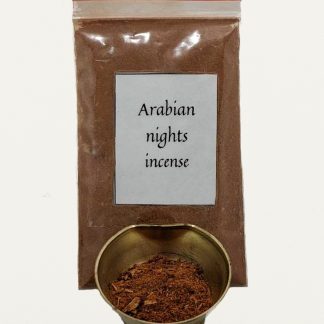Description
Time period: Evergreen
Ingredients: A blend of musk, frankicense, calamus root, sweet orange peel, red sandlewood, sotrax, cypress roots, mastic, lemon essential oil
Product volume: 15 g
Use: For Charocal burners. Sprinkle a pinch of the incense over the burning charcoal to release the fragrance.
Warnings: Burning incense should never be left unattended, and always used in an appropriate vessel.
Storage: We suggest keeping the incense in an airtight container in a cool, dark place away from the intense Australian sun.
From Medieval Still Room:
All of the ingredients we use and sell are either organically grown by us or sourced locally from organically certified growers. We do not source ‘wild harvested’ ingredients as many of the plants are endangered, and are harvested without regard to the continued health of the plant, the local community, or the plant species as a whole.
As with any product made on organically grown heritage plant matter, there may be slight variations in colour and consistency between batches however, we do our best to ensure that there is no change in the efficacy of the product.
Potted History;
The secular and ecclesiastical use of incense began long before the medieval period and continues to this day. Dry loose incense powders are burned on charcoal tablets (seated in sand) in a small fireproof container such as a brazier. Powders are sprinkled onto the charcoal and the intense heat from the burning charcoal releases the fragrance.
Incense was an important part of the medieval household in part due to the belief that beautiful smells created good health and indicated a healthy environment. The incense could be a single substance such as sandalwood or frankincense, but most often it was a blend of a number of botanical and resinous substances. This practice both bulked out precious incense powders such as frankincense and myrrh, and also enabled unique combinations of scents tailored to a customers requirements. Many scents were associated with healing properties, others as fumigants (both spiritual and for insects), and as a way of dissipating negative and enhancing positive emotions, releasing stress and alleviating pain.
A surprising number of extant texts have survived, describing not only the ingredients used, but also recipes, notes on best use, and where to source rare ingredients. Apothecary invoices, shipping manifests, published folios and home recipe books all enable us to recreate the some of the scents that were favoured during the medieval period.

Reviews
There are no reviews yet.